by Christopher S. | Nov 7, 2024 | App Store Optimization, Blogs |
Introduction About Top ASO Tools
With the sheer volume of apps available in 2024, standing out in the app stores has never been more challenging. This is where App Store Optimization (ASO) comes into play. ASO is like SEO for apps, aiming to improve app visibility, attract more downloads, and ultimately secure app success in a crowded market. Let’s dive into the top ASO tools that can help you make a powerful impact in the app store.
What is ASO and Why is it Crucial?
ASO encompasses strategies and techniques to improve app ranking in search results within app stores. A good ASO strategy focuses on optimizing keywords, app descriptions, visuals, and user feedback to boost visibility and download rates.
Factors Influencing ASO
Several factors drive ASO success, and understanding them helps in selecting the right ASO tools:
- Keywords and Metadata: Proper keyword usage in titles and descriptions ensures your app appears in relevant searches.
- User Reviews and Ratings: High ratings improve visibility and encourage downloads.
- Visuals and User Experience: Screenshots, videos, and app icons significantly impact conversion rates.
Top ASO Tools to Use in 2024
To achieve the best results, here’s a curated list of the top ASO tools designed to meet various ASO needs.
#1: AppTweak
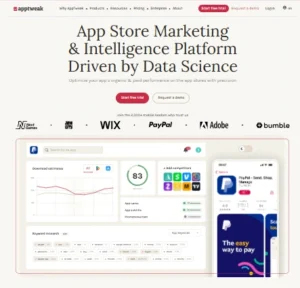
Key Features: AppTweak provides data-driven insights on keywords, ad intelligence, and ASO performance across app stores.
Pros: Known for its robust keyword research features and user-friendly interface.
Cons: Pricing might be a bit high for smaller developers.
Website URL: www.apptweak.com
#2: Sensor Tower

Key Features: Sensor Tower specializes in competitive analysis, giving insights into how your app stacks up against competitors.
Pros: Exceptional for tracking competitor performance and identifying emerging trends.
Cons: Not as focused on keyword discovery for beginners.
Website URL: www.sensortower.com
#3: AppFollow
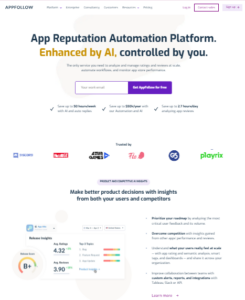
Key Features: AppFollow emphasizes tracking user feedback, helping you respond to reviews and ratings efficiently.
Pros: Great for maintaining a positive user rating, which can boost visibility.
Cons: Limited in keyword optimization tools compared to others.
Website URL: www.appdollow.io
#4: Mobile Action
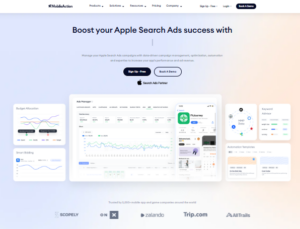
Key Features: Known for its unique advertising insights, Mobile Action is excellent for those looking to integrate ASO with paid marketing.
Pros: Combines ASO with ad insights, making it ideal for a holistic approach.
Cons: Some features are limited in the free version.
Website URL: www.mobileaction.co
#5: TheTool
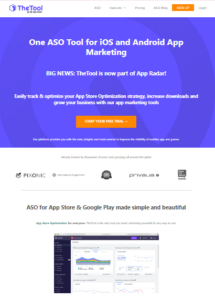
Key Features: TheTool’s intuitive dashboard allows you to monitor all ASO metrics in one place.
Pros: Perfect for beginners due to its ease of use and visual representation of ASO metrics.
Cons: Lacks advanced features required by more experienced ASO professionals.
Website URL: www.thetool.io
#6: ASOdesk

Key Features: ASOdesk stands out for its ability to generate keyword suggestions tailored to your app’s niche.
Pros: Ideal for keyword discovery, especially for niche apps.
Cons: Limited in tracking visual assets compared to other tools.
Website URL: www.asodesk.com
#7: Keyword Tool
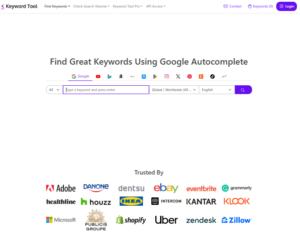
Key Features: Keyword Tool focuses on keyword discovery and tracking, which is central to improving app search rankings.
Pros: Excellent for those focused primarily on keyword optimization.
Cons: Limited in competitive insights.
Website URL: www.keywordtool.io
Comparing Paid vs. Free ASO Tools
Free ASO tools can be great for startups with limited budgets, but paid tools often provide additional features, such as competitor analysis and ad insights. For scaling businesses, investing in a paid tool can deliver valuable, in-depth data that free tools may not offer.
How to Choose the Top ASO Tool for Your Needs
When selecting an ASO tool, consider your budget, primary goals (keywords, reviews, or competitive analysis), and the app’s current market position. For instance, a new app may prioritize tools focused on keywords, while a seasoned app may focus more on competitive analysis.
Best Practices for Using ASO Tools
- Regularly Update Keywords: App trends shift often; updating keywords monthly can help maintain relevance.
- Engage with User Feedback: Responding to reviews, especially negative ones, can improve ratings.
- Track Competitors: Monitoring competitor strategies can reveal gaps or new opportunities for optimization.
Conclusion
In today’s competitive app market, having the Top ASO tools can make all the difference between getting noticed and getting lost. By leveraging top tools like AppTweak, Sensor Tower, and Mobile Action, app developers can optimize keywords, monitor competitors, and engage users effectively, driving more downloads and engagement.
To further enhance your app’s reach and success, consider partnering with App Marketing Plus. As a dedicated app marketing agency, App Marketing Plus specializes in boosting app visibility, user acquisition, and downloads through advanced ASO strategies tailored to your app’s unique needs. From keyword optimization to conversion-focused advertising, we provide everything you need to stand out in the app store. Ready to make your app shine? Visit App Marketing Plus today and start maximizing your app’s potential!
FAQs
1. What is the Top ASO tool for beginners?
For beginners, tools like The Tool and AppTweak are great due to their user-friendly interfaces and essential ASO features.
2. How often should I update my ASO strategy?
Ideally, update your ASO strategy every 30-60 days to align with trends and maintain keyword relevance.
3. Can Top ASO tools replace an ASO specialist?
No, while ASO tools are powerful, they complement rather than replace the expertise and strategy of a specialist.
4. What’s the average cost of Top ASO tools?
Prices vary widely, from free to several hundred dollars per month depending on the features and capabilities.
5. Do ASO tools work for both iOS and Android?
Yes, most ASO tools offer support for both iOS and Android platforms, but it’s wise to confirm compatibility.
by Christopher S. | Oct 15, 2024 | Blogs |
Launching an app is just the beginning of a long journey. To ensure success, implementing the right marketing strategies is essential. This guide covers 10 must-know app marketing strategies to help your app thrive in a competitive market.
1. Optimize for App Store Visibility (ASO)
on od the best App Marketing Strategies is App Store Optimization (ASO) is crucial for increasing your app’s visibility. By using targeted keywords in your app’s title, description, and metadata, you improve its ranking. High-quality images, screenshots, and an engaging app icon also contribute to better conversion rates.
2. Leverage Social Media Marketing
Second most App Marketing Strategies is Social media platforms like Instagram, Facebook, and Twitter are ideal for promoting your app. Regularly post engaging content, videos, and app tutorials. Collaborating with influencers can also amplify your app’s reach to a broader audience.
3. Create a Pre-Launch Campaign
Building excitement before your app’s launch can create a buzz. Set up a landing page, run teaser campaigns, and collect emails to keep potential users updated. A pre-launch campaign ensures you have a ready audience on day one.
4. Offer Incentives and Referral Programs
Offer special incentives like discounts, premium features, or rewards to users who invite others. A referral program encourages users to share your app, growing your user base organically.
5. Engage with Push Notifications
Push notifications are an effective tool for retaining users. Send personalized messages, updates, or reminders about new features. However, avoid overloading users with too many notifications, as it can lead to uninstalls.
6. Invest in Paid Ads
Google Ads, Facebook Ads, and Instagram Ads are excellent platforms for driving traffic to your app. Use well-targeted campaigns to reach potential users based on demographics, interests, and behaviors. Paid ads can give your app the initial boost it needs.
7. Build an Engaging Website
A website acts as a central hub for information about your app. Optimize it for SEO by including relevant keywords, and ensure it is user-friendly. Having an engaging website helps with organic discovery and boosts your app’s credibility.
8. Focus on Content Marketing
Creating valuable content such as blogs, videos, and how-to guides can attract potential users. This content not only educates your audience but also improves your app’s SEO. Share your content across social media platforms and other channels.
9. Collaborate with Influencers and Bloggers
Influencers and bloggers who specialize in your app’s niche can give your app credibility. Reach out to them for reviews, testimonials, or sponsored content. Their audience trusts their opinion, making this a powerful marketing strategy.
10. Track and Analyze Performance
Use tools like Google Analytics and in-app analytics to track user behavior, acquisition channels, and conversion rates. Understanding these metrics helps you optimize your marketing strategies and improve user engagement.
By implementing these 10 App Marketing Strategies, you’ll boost your app’s visibility, increase downloads, and ultimately, ensure its success in the competitive app market.
Conclusion
Mastering app marketing is key to your app’s success. By leveraging the strategies discussed, including ASO, social media marketing, and paid ads, you can significantly increase visibility, user acquisition, and retention. For a comprehensive app marketing solution that integrates all these App Marketing Strategies and more, consider App Marketing Plus. With expert guidance and a customized plan, App Marketing Plus will help you reach your app’s full potential.
FAQ
Q1: What is App Store Optimization (ASO)?
ASO is the process of improving your app’s visibility in the app stores by optimizing its title, keywords, description, and images.
Q2: How can I increase app downloads through social media?
By posting engaging content regularly, collaborating with influencers, and running targeted ads on platforms like Facebook, Instagram, and Twitter, you can drive more traffic to your app.
Q3: Why are push notifications important?
Push notifications help you engage and retain users by reminding them about your app’s features, updates, and special offers.
Q4: Should I invest in paid ads for my app?
Yes, paid ads are effective for reaching a larger audience quickly. Platforms like Google Ads and Facebook Ads allow you to target users based on their behavior and interests.
Q5: How can I track my app’s marketing performance?
Using analytics tools like Google Analytics, you can track user behavior, downloads, and the effectiveness of your marketing campaigns to make data-driven decisions.
by Christopher S. | Sep 30, 2024 | Blogs |
How to Promote Your Mobile App
Promote Your Mobile AppsYou’ve poured your heart into creating your mobile app. Endless hours of coding, design, and testing have gone into it, and now it’s finally here (How to Promote Your Mobile App ) — ready to change the world. But there’s one small hurdle left: getting people to actually use it. How do you make sure that the app you worked so hard on doesn’t just disappear into the vast sea of the app stores?
Promoting your app isn’t just a step; it’s the key to unlocking the success you’ve dreamed of. Without it, all that hard work could go unnoticed. But with the right strategy, your app can soar.
Understanding Mobile App Promotion
What Does App Promotion Involve?
App promotion is much more than just telling people, “Hey, my app exists!” It’s about strategically connecting your app with the people who will truly benefit from it. Think of it as a bridge between your app and its future users.
Why Just Building Isn’t Enough
The truth is, simply building a fantastic app isn’t enough anymore. The app market is flooded with options, so if you don’t make your presence known, it’s like shouting in a room full of people—no one’s going to hear you unless you stand out. Promotion is how you turn heads.
Defining Your Target Audience
Who Will Benefit Most from Your App?
Before you start promoting, you need to know who you’re promoting to. Who is your app designed for? Defining your target audience allows you to create tailored marketing messages that resonate on a personal level. Your app isn’t for everyone, and that’s okay! It’s for the people who need it most.
Understanding User Pain Points
What problems does your app solve? If you can communicate the solution your app offers to a specific problem, your audience will immediately pay attention. People aren’t just looking for cool apps—they’re looking for solutions.
App Store Optimization (ASO)
Mastering the App Store
App Store Optimization (ASO) is your first weapon in the app promotion battle. It’s all about optimizing your app’s listing in app stores to make it more discoverable. Just like SEO for websites, ASO ensures that your app ranks higher in search results.
The Importance of Keywords
One of the key factors in ASO is choosing the right keywords. What terms are your potential users searching for? Integrating those keywords into your app description and title will make your app more likely to be found by the right people.
Leveraging Social Media Marketing
Building Buzz on Social Platforms
Social media is where your app can come to life. Use platforms like Instagram, Twitter, and Facebook to build anticipation before the app even launches. Share sneak peeks, features, and the story behind why you created it. The more relatable and engaging your content, the more likely people are to share it.
Paid Ads vs. Organic Growth
Paid advertising on social media can give you a quick boost, but organic growth—where people share your app out of genuine excitement—is what will sustain long-term success. A mix of both will help you cover all bases.
Creating Engaging Content
Blog Posts and Articles
Content marketing is another key component of promoting your app. Writing blog posts or articles about how your app solves problems can position it as an expert solution. Focus on topics that interest your audience and that relate to the core purpose of your app.
Videos and Tutorials
People love visuals. Create how-to videos, tutorials, or even behind-the-scenes content to show what makes your app special. Make it fun, make it engaging, and most importantly, make it useful.
Influencer Marketing
Choosing the Right Influencers
Partnering with influencers in your niche can give your app a massive boost. But don’t just go for the big names. Sometimes, micro-influencers who have a highly engaged, smaller audience are more effective. The key is finding influencers whose audience aligns with your target users.
Authenticity Over Numbers
It’s tempting to choose influencers based on their follower count, but what really matters is authenticity. Does the influencer genuinely like your app? Will their endorsement feel sincere to their audience? If the connection feels forced, it won’t work.
Utilizing Email Marketing
Crafting the Perfect Email Campaign
Email marketing is still one of the most effective ways to reach your audience directly. Build an email list before launch and use it to keep people updated on your app’s progress, features, and exclusive offers.
Timing and Frequency
Don’t bombard your audience with emails, but don’t go silent either. Finding the right balance of regular updates without overwhelming your subscribers is key.
Paid Advertising Strategies
Google Ads, Facebook Ads, and Beyond
Paid ads are an investment in your app’s visibility. Platforms like Google Ads and Facebook Ads allow you to target specific demographics. You can tailor your ad campaigns to reach people based on their age, location, interests, and more.
Getting the Most from Your Budget
Paid ads can be costly if not handled correctly. Start with a small budget, test different ads, and see which ones perform the best. Then, double down on what works.
Partnering with Other Apps and Platforms
Cross-Promotions That Make a Difference
Collaborating with other apps can open doors to new audiences. Find apps that complement, not compete with, yours and set up cross-promotion strategies that benefit both of you.
Finding Synergistic Partnerships
Look for synergies where both apps or platforms can benefit. For example, a fitness app could partner with a healthy eating app, offering users value from both angles.
Gathering and Leveraging User Reviews
Why Reviews Matter
User reviews are the social proof your app needs. When new users see positive feedback, they’re more likely to download your app. It’s a trust signal.
Encouraging Users to Share Their Experiences
Prompt users to leave reviews through in-app notifications or emails. Offer incentives like discounts or exclusive features in exchange for their feedback.
Hosting a Launch Event
Online vs. Offline Launch Events
Depending on your audience, you can choose to host a virtual or physical launch event. Online events allow you to reach a global audience, while offline events can create a more intimate, personal connection.
Creating a Memorable Experience
No matter the format, make sure your launch event is memorable. Showcase the best features of your app, offer exclusive access, and engage directly with attendees.
Tracking and Analyzing Your Promotion’s Success
The Importance of Analytics
You won’t know how effective your promotion is unless you track it. Use analytics tools to monitor downloads, user engagement, and other key metrics.
Adjusting Your Strategy Based on Data
If something isn’t working, change it. Analyze the data and tweak your strategy to focus on what’s delivering the best results.
Maintaining Momentum Post-Launch
Consistent Updates and New Features
Don’t let your app go stale after launch. Regular updates and new features keep users engaged and show that you’re committed to improving the experience.
Keeping Your Audience Engaged
Ongoing communication with your audience through social media, email, or in-app notifications will help you keep users excited about your app long after the initial launch.
Conclusion
Promoting your mobile app is more than just marketing—it’s about sharing your vision with the world. Every feature you built, every problem your app solves, and every user you reach brings you closer to success. But remember, you don’t have to do it alone.
App Marketing Plus can be the partner you need on this journey they know How to Promote Your Mobile App. With expert strategies tailored specifically to your app’s needs, we help you break through the noise and reach the people who need your app the most. Whether it’s mastering App Store Optimization, running targeted ad campaigns, or building buzz on social media, App Marketing Plus is here to turn your hard work into the recognition it deserves.
Let’s work together to take your app from idea to sensation. Your success story is waiting to be written, and App Marketing Plus is ready to help you write it.
FAQs
- How much should I budget for app promotion?
It depends on your goals and target audience. Start with a modest budget, test, and scale based on performance.
- What’s the best social media platform for promoting my app?
The best platform depends on your audience. Instagram are great for younger audiences, while LinkedIn may work better for business apps.
- How long does it take to see results from app promotion?
Results vary, but with consistent effort, you can start seeing progress within a few weeks to a few months.
- Is it worth investing in influencer marketing?
Yes, if done correctly. Choose influencers who align with your app’s values and have an engaged audience.
- Can I promote my app without spending any money?
Absolutely! Organic methods like ASO, content marketing, and social media engagement can all be effective without a financial investment.
by Christopher S. | Sep 24, 2024 | Blogs, games |
Freemium games have taken the gaming world by storm, offering players access to great content without needing an upfront purchase. With an array of engaging games that provide free-to-play experiences combined with optional in-game purchases, freemium games have become a favorite for casual and dedicated gamers alike. Whether you love action-packed adventures, mind-bending puzzles, or relaxing simulators, here are the Top 10 Freemium Games You Should Try Today!
Top 10 Freemium Games
An open-world action RPG, Genshin Impact offers stunning visuals and a captivating storyline. Players can explore the vast world of Teyvat, meet various characters, and unlock new abilities. The game’s gacha system provides in-game purchases but remains fun without spending.
A global phenomenon, Fortnite mixes battle royale combat with a creative mode where players can build and destroy environments. Though skins and emotes come with a price, the base game is free, making it one of the most popular freemium games around.
If you’re into first-person shooters, Call of Duty: Mobile is a must-try. It includes multiple game modes like Battle Royale and Team Deathmatch, providing console-quality action on mobile. In-app purchases give players cosmetic upgrades, but the core gameplay remains free.
Wild Rift brings the legendary League of Legends experience to mobile devices, with exciting 5v5 MOBA gameplay. While you can purchase skins and other cosmetic items, all champions and essential gameplay elements can be unlocked for free through in-game progress.
Combining elements of tower defense, card games, and real-time strategy, Clash Royale has become a favorite for mobile gamers. It’s easy to pick up but offers plenty of strategic depth. While players can buy cards or chests, it’s perfectly enjoyable without spending a dime.
Apex Legends redefined the battle royale genre, and now its mobile version does the same. Fast-paced and packed with unique characters, Apex Legends Mobile is a solid freemium title. Cosmetic purchases are available, but they don’t impact gameplay.
Candy Crush Saga is the ultimate casual game, offering hundreds of puzzle levels with increasing difficulty. You can play indefinitely, but players can buy extra lives and boosters to advance more quickly. Despite its simplicity, it’s incredibly addictive and fun.
PlayerUnknown’s Battlegrounds (PUBG) is one of the most intense battle royale games you can find. The mobile version offers the same thrilling experience, with a focus on survival. While in-game purchases are available for skins and passes, the base game provides hours of entertainment for free.
Social deduction at its finest, Among Us challenges players to work together to complete tasks while identifying the impostor among the crew. It’s a free game with cosmetic purchases and some paid content, but even the base game will keep you hooked for hours.
An augmented reality (AR) game that took the world by storm, Pokemon GO allows players to catch, trade, and battle Pokémon in the real world. While in-game purchases for items can speed up your progress, it’s free to play and perfect for both casual and competitive gamers.
Why Freemium Games Are Popular
Freemium games offer a perfect balance between free accessibility and optional paid content, allowing players to experience full-fledged games without upfront costs. Whether you’re looking for competitive gameplay or casual experiences, freemium models allow you to explore games without commitment. The only thing you need is time!
Conclusion: Level Up Your Freemium Games with App Marketing Plus
If you’re a developer looking to break into the freemium market or seeking to optimize your existing app’s performance, it’s essential to partner with experts who understand the gaming industry. AppMarketingPlus is a leading app marketing agency that specializes in boosting visibility, increasing downloads, and enhancing the monetization of freemium games. From ASO (App Store Optimization) to targeted marketing campaigns, AppMarketingPlus can help your game reach its full potential.
Ready to skyrocket your freemium game’s success? Visit AppMarketingPlus.com today to learn how they can help you dominate the app market!
FAQ’s
1. What are freemium games?
Freemium games are free-to-play games that offer optional in-game purchases. You can enjoy the core gameplay without spending money, but certain features like cosmetic items, extra levels, or power-ups may be available for purchase.
2. Do I need to spend money to enjoy freemium games?
No, the beauty of freemium games is that they offer a full gaming experience without any required payment. Optional in-game purchases exist to enhance the experience or speed up progress, but they are not mandatory for enjoying the game.
3. Are freemium games safe for kids?
Most freemium games are safe for kids but may include in-game purchases. Parents should ensure that purchase settings are restricted and review the game’s content ratings to make sure it’s appropriate for their child.
4. Can I play freemium games offline?
Some freemium games, like Candy Crush Saga, can be played offline. However, many others, especially multiplayer or AR-based games like Fortnite and Pokemon GO, require an internet connection.
5. How do in-game purchases work in freemium games?
In-game purchases allow players to buy items such as skins, extra lives, or power-ups using real money. These purchases are optional and usually enhance gameplay or offer cosmetic upgrades.
by Christopher S. | Sep 23, 2024 | Blogs |

Mobile app beta testing services
In the ever-competitive world of mobile games, achieving visibility and downloads in app stores is no small feat. Top Mobile Game Marketing Agencies play a crucial role in ensuring the success of apps. From driving organic traffic to boosting user engagement, these agencies help developers thrive in the marketplace.
What Makes Mobile Game Marketing Agencies Unique?
Mobile game marketing requires a combination of creativity and strategy. Unlike traditional apps, games need to capture users’ attention instantly. A successful marketing campaign focuses on creating a loyal community of gamers while maximizing in-app purchases and downloads.
Key Strategies Employed by Top Agencies
Mobile game marketing agencies use a blend of strategies to boost app visibility:
- App Store Optimization (ASO) One of the primary strategies is ASO. By optimizing app titles, descriptions, and keywords, agencies ensure that games rank high in search results, driving organic traffic and downloads.
- Influencer Marketing Partnering with gaming influencers and streamers is another effective tactic. These influencers promote the game to their large audiences, creating buzz and excitement.
- Social Media Advertising Platforms like Facebook, Instagram, and LinkedIn offer incredible opportunities for targeted ads. Mobile Game Marketing Agencies create eye-catching ads that engage users and lead to app downloads.
Top Mobile Game Marketing Agencies
Several agencies stand out for their success in promoting mobile games. These include:
- AppLift: AppLift is a leader in user acquisition for mobile games. Their approach combines data-driven advertising with creative content to drive long-term engagement.
- AppMarketingPlus: Based in India, App is a full-service mobile app marketing agency that has been instrumental in the growth of many mobile games. They specialize in ASO and digital marketing, driving impressive results for their clients.
- Liftoff : Liftoff focuses on programmatic ad buying and uses machine learning to optimize ad performance. Their campaigns have helped countless developers reach millions of users.
Conclusion: Choosing the Right Agency for Your Game
Selecting the right mobile game marketing agency is critical for success in the competitive app market. Whether it’s ASO, influencer marketing, or social media ads, top agencies like App Marketing Plus know how to get your game in front of the right audience.
FAQ’s for Mobile Game Marketing Agencies
What is mobile game marketing?
Mobile game marketing involves promoting mobile games to attract more downloads and increase user engagement. It includes strategies like app store optimization (ASO), influencer marketing, and social media advertising.
Why is App Store Optimization (ASO) important?
ASO helps mobile games rank higher in app store searches by optimizing keywords, descriptions, and titles, which increases visibility and organic downloads.
How do mobile game marketing agencies use social media?
Agencies use platforms like Facebook, Instagram, and TikTok to run targeted ads that reach specific audiences, driving more downloads and engagement.
What role do influencers play in mobile game marketing?
Gaming influencers promote mobile games to their large followings, creating buzz and encouraging users to download and play the game.
Which are the top mobile game marketing agencies?
Some of the top agencies include App Marketing Plus, AppLift, Liftoff, each offering specialized strategies for driving mobile game success.
by Christopher S. | Sep 20, 2024 | App Store Optimization, Blogs |
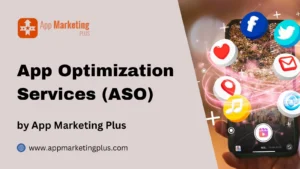
App Optimization Services
In today’s competitive digital landscape, app optimization is crucial for success. Businesses invest in app development, but without proper optimization, your app could remain invisible in app stores. To make sure your app stands out, it’s essential to implement effective app marketing strategies. Let’s dive into the key aspects of app optimization services by app marketing plus and how they can drive success.
What is App Store Optimization (ASO)?
App Store Optimization (ASO) is the process of improving the visibility of a mobile app in app stores such as Google Play and Apple’s App Store. It involves optimizing various elements like app title, description, and keywords to ensure that your app ranks higher in search results. Higher rankings lead to more downloads, ultimately boosting your app’s success.
Why ASO Matters for Your App
ASO is essential because it directly impacts the discoverability of your app. With millions of apps available, users often rely on search results within app stores to find the right solution. A well-optimized app has a higher chance of appearing at the top, increasing the chances of being downloaded. It’s a long-term strategy to maintain steady traffic and user engagement.
Key Factors to Boost Your App Ranking
1. Relevant Keywords
Identifying and integrating relevant keywords into your app’s title and description is vital for ASO success. These keywords help the app store algorithms understand what your app is about and match it with user queries. Conduct thorough keyword research to ensure that you’re targeting terms that your audience is searching for.
2. Compelling App Title and Description
Your app’s title should be concise yet informative. It must include the main keyword for better visibility. Similarly, the description needs to be engaging, highlighting the app’s key features, functionalities, and benefits. A clear call-to-action in the description can also drive users to download the app.
3. High-Quality Screenshots and Videos
Visual elements play a significant role in convincing potential users to download your app. Make sure you include high-quality screenshots that display the app’s features and interface. A short, informative video can also boost your app’s credibility, showing users exactly how the app works.
4. Positive Reviews and Ratings
Positive reviews and high ratings are indicators of an app’s quality. Encourage satisfied users to leave reviews and ratings. App store algorithms take these into account, and apps with better ratings tend to rank higher. Responding to reviews, both positive and negative, can also show that you care about user experience.
5. Regular Updates
Keeping your app up-to-date is essential for maintaining user satisfaction and improving your ranking. Regular updates with bug fixes, new features, or design improvements show that your app is active and evolving. It also keeps users engaged and returning for the latest features.
App Marketing: Expanding Beyond ASO
While ASO is critical for initial discoverability, app marketing expands your reach beyond app stores. Promoting your app through various digital marketing channels ensures that you engage with a broader audience. Here are a few app marketing strategies to consider:
1. Social Media Promotion for App Optimization Services
Social media platforms like Facebook, Instagram, and Twitter offer excellent opportunities to promote your app. Create engaging posts, share user testimonials, and run targeted ads to attract new users. Social media is also a great place to gather feedback and interact with your audience.
2. Influencer Partnerships
Collaborating with influencers who align with your app’s target audience can significantly boost your app’s visibility. Influencers can showcase your app to their followers, providing credibility and encouraging downloads.
3. Paid Advertising Campaigns
Paid campaigns such as Google Ads and Facebook Ads can drive immediate traffic to your app. With precise targeting, you can ensure that your ads are shown to users most likely to be interested in your app. Monitor these campaigns closely to optimize performance and ROI.
The Role of Data and Analytics in App Optimization Services
Tracking and analyzing user data is crucial to the success of your app. It helps you understand user behavior, preferences, and areas for improvement. Tools like Google Analytics or in-app analytics platforms can provide insights into how users interact with your app, allowing you to make informed decisions on updates and marketing efforts.
1. User Engagement Metrics
Metrics such as daily active users (DAU), session length, and user retention rate provide valuable information about how engaged your users are. Higher engagement often leads to better app store rankings, as it signals to the algorithm that users find your app valuable.
2. Conversion Rate Optimization
Optimizing the conversion rate is essential for turning app visitors into loyal users. From the app store listing to in-app features, each step should be optimized to provide the best possible user experience and encourage downloads.
Conclusion: Elevate Your App’s Success with App Optimization Services
App optimization services are the backbone of a successful app marketing strategy. By focusing on ASO, leveraging marketing strategies, and analyzing user data, you can significantly increase your app’s visibility, downloads, and long-term success. Whether you’re launching a new app or looking to improve an existing one, these techniques are essential to driving growth in today’s competitive app landscape.
FAQs
1. What is App Store Optimization (ASO)?
App Store Optimization (ASO) is the process of enhancing your app’s visibility in app stores like Google Play and Apple’s App Store. It involves optimizing the title, description, keywords, and other elements to rank higher in app search results, leading to more downloads.
2. Why is App Optimization Services important for my app?
App Optimization Services is essential because it improves your app’s visibility in app store search results. This increased visibility directly impacts the number of downloads, which helps boost app performance and success.
3. How do keywords affect app optimization?
Keywords are crucial in ASO because they help app store algorithms understand your app’s purpose and content. By including relevant keywords in your app title and description, you can rank higher for search queries related to your app.
4. How can I improve my app’s ranking in app stores?
To improve your app’s ranking, you should focus on ASO factors such as relevant keywords, a compelling title, high-quality screenshots, positive reviews, and regular app updates.
5. What are some key app marketing strategies beyond ASO?
In addition to ASO, you can promote your app through social media, influencer partnerships, and paid advertising campaigns on platforms like Google Ads and Facebook.









